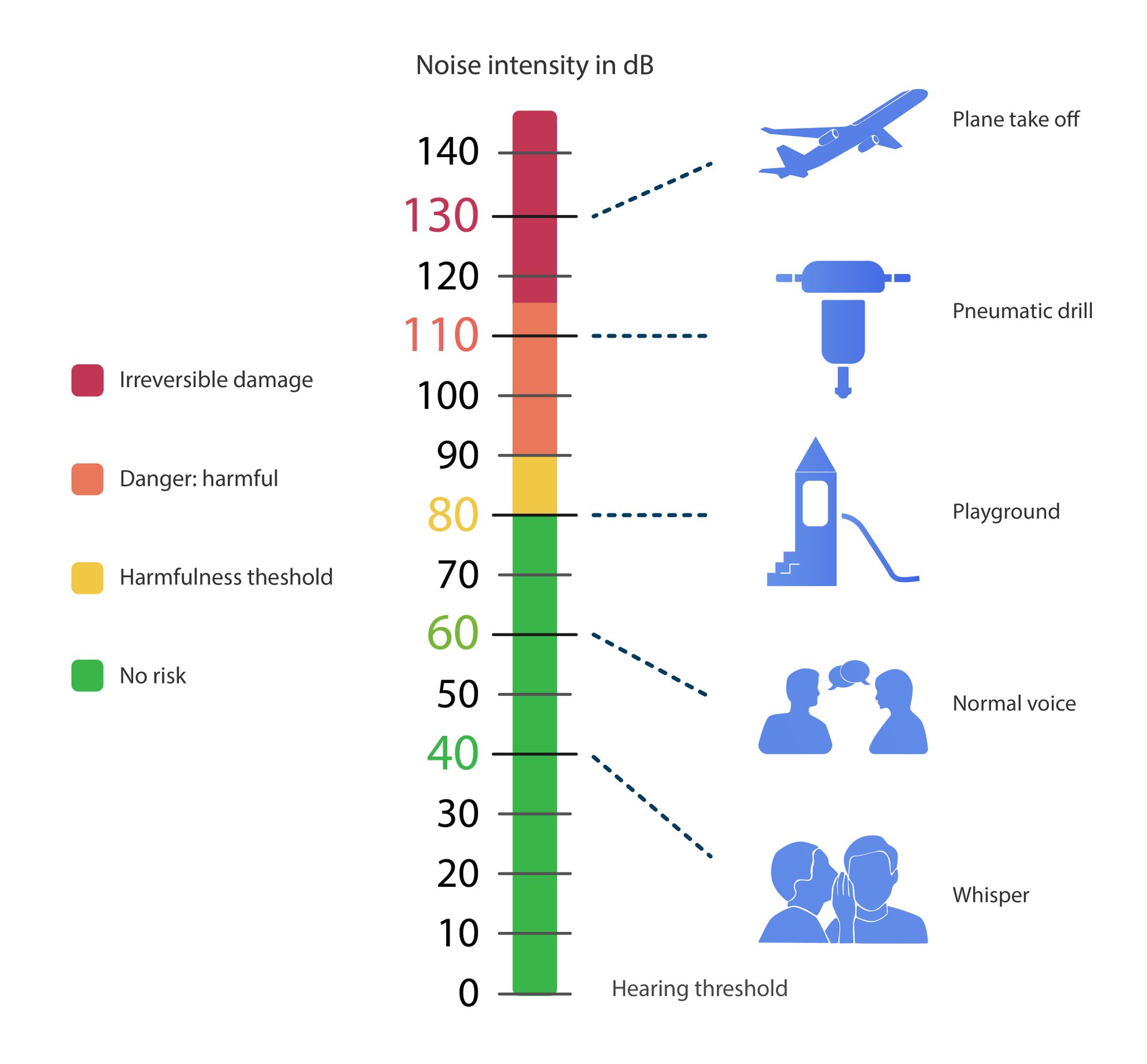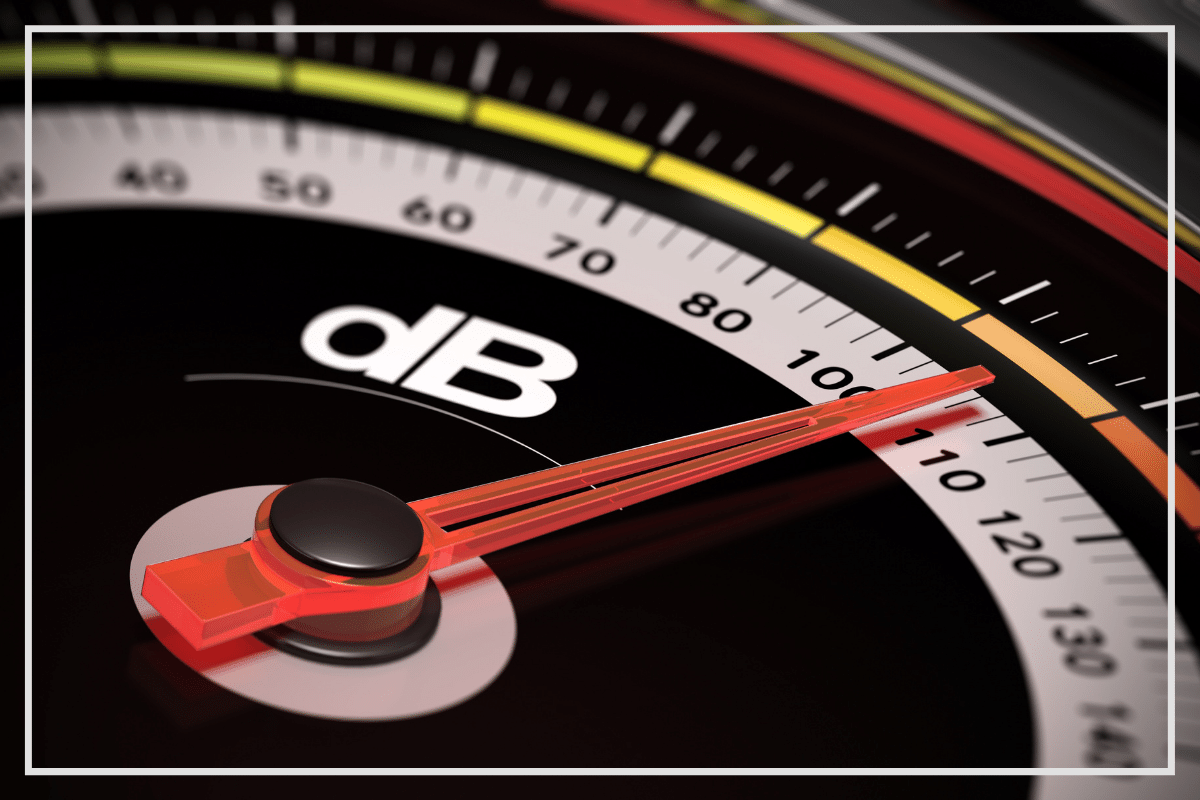- How Loud Is A Decibel
1.1 For adults
1.2 For children
1.3 For people with hearing loss - Is It Safe For Humans
- How To Protect Your Hearing
3.1 Turn down the volume
3.2 Walk away from loud sounds
3.3 Wear hearing protection - Health Effects Of Loud Noises
- Get More Info About Decibels With Decibel Pro App
You’ve surely heard about decibels left and right. They show us how loud a sound is. But do you know how loud one decibel is?
In this article, we’re looking at how loud one decibel is to understand if it is safe for humans. Read on to learn all about it.
How Loud Is a Decibel?
Sound is made up of energy and it travels in waves. To measure these waves, we look at their frequencies and their amplitude. The measurement unit for frequency (vibrations per second) is Hertz (Hz), and the measurement unit for amplitude (pressure or intensity) is the decibel (dB).
The decibel scale shows us how intense a sound is. The higher the number of decibels is, the louder the sound.
One more important aspect we need to know about measuring sound in decibels is that the decibel scale is logarithmic. This means that 10 dB is 10 times louder than 0 dB but 20 dB is 100 times louder than 0 dB. And so on.
So, what does this all mean? How loud is one decibel?
While it’s easy to assume that a reading of 0 decibels means total silence, 0 dB is actually the threshold of human hearing. That means that while different frequency sounds may still exist in a 0 dB environment, we won’t be able to perceive them.
On the other hand, the only environment where you can measure 0 dB is an anechoic chamber. These are special scientific environments with soundproof walls and ceilings.
In a normal room - for example, your bedroom - no matter how quiet it is, you will still get a reading of 10 dB or more. If you factor in the sound made by appliances or even your breathing, the decibel level will exceed 20-30 dB.
Take a look at the graphic below showing common decibel levels to better understand how loud a decibel is:

For Adults
As explained above, it would be almost impossible to create a 1 dB environment outside of scientific labs. However, adults with optimal hearing health will be able to perceive a 1 dB difference in sounds. This is because adults have the ability to separate different sounds and focus on the ones they want to hear.
For instance, they can sense if the volume of a song playing on a sound system is turned up even if the difference is only one decibel.
However, adult hearing sensitivity decreases with age and, as they get older, adults gradually lose their ability to hear such fine differences between decibel levels.
For Children
Babies and young children have more sensitive hearing than adults. That is why it is assumed that they also have better hearing. However, babies have a harder time identifying where sounds come from as their ability to focus on a certain sound is not developed.
Children with sensitive hearing may be able to detect a one-decibel difference between sounds.
For People With Hearing Loss
Because people with hearing loss have lost their ability to perceive sounds in the same way healthy people do, they won’t be able to detect a 1 dB difference between sounds. Depending on the severity of their hearing loss, they may or may not hear sounds that are only as loud as one decibel.
Is It Safe for Humans?
When it comes to human hearing, sounds at or below 70 dB are considered safe. As 1 decibel is under this limit, this level is also considered safe for human hearing.
Sounds at or above 85 dB are considered potentially dangerous if your exposure to them is extended (i.e., several hours per day). Sounds above 90 dB are considered dangerous and exposure to them should be limited. In such cases, a 1-decibel difference can be important and make the difference between hearing damage and hearing loss.
How to Protect Your Hearing
The harmful effects of loud noise can lead to noise-induced hearing damage and noise-induced hearing loss (NIHL). Preventing unnecessary exposure, protecting ourselves from loud noises, and paying attention to the warning signs of hearing damage are the best ways to protect our hearing.
For sounds under 70 decibels, you don’t need hearing protection or to take special protection measures. However, for sounds above 70 and especially 85 decibels such as when you are operating heavy machinery, listening to music on your headphones. or using your lawnmower, you should:
Turn Down the Volume
Many people enjoy listening to loud music or playing video games. As pleasant as these activities may be, we need to be aware that extended exposure to sounds above 85 dB can be harmful to our hearing.
The best way to protect your hearing is to limit exposure time or turn down the volume. For headphones, the golden rule is to listen to music at 60% of the volume for no more than 60 minutes at a time.
Walk Away From Loud Sounds
The easiest way to protect your hearing when you are exposed to louder sounds is to walk away from the source. Proximity affects how loud you perceive a sound.
As you move away from the source of the noise, the decibel level drops by 6 decibels each time you double your distance from it.
Wear Hearing Protection
Hearing protection is another simple way to protect the human ear. Earplugs are easily available in drug stores and some are made of foam to fit the exact shape of your ear.
Earmuffs are better for when you are exposed to very loud noise. They fit over the outer ear, are adjustable, and completely block out noise.
Another option is noise-canceling headsets. They block outside noise while also allowing you to communicate with others.
Health Effects of Loud Noises
Loud noises can have a variety of effects on the human ear and our bodies.
The most common health effects of loud noise are:
- Annoyance and irritation
- Increased anxiety and stress levels
- Hypertension
- Increased blood pressure and adrenaline and cortisol levels
- Sleep disturbance
- Immune system effects
- Hearing damage
- Hearing loss
Get More Info About Decibels with the Decibel Pro App
If you are looking for a quick and easy way to measure decibel levels, a sound level meter app like Decibel Pro is all you need.
With a decibel app like Decibel Pro, you get instant readings of noise levels on your phone. Because it is calibrated with high-quality equipment, the app can detect the slightest differences in sound level and show you just how loud a decibel is.
To use Decibel Pro, simply go to the AppStore, download it on your iPhone or iPad.
To learn more about the Decibel Pro app, click here.



